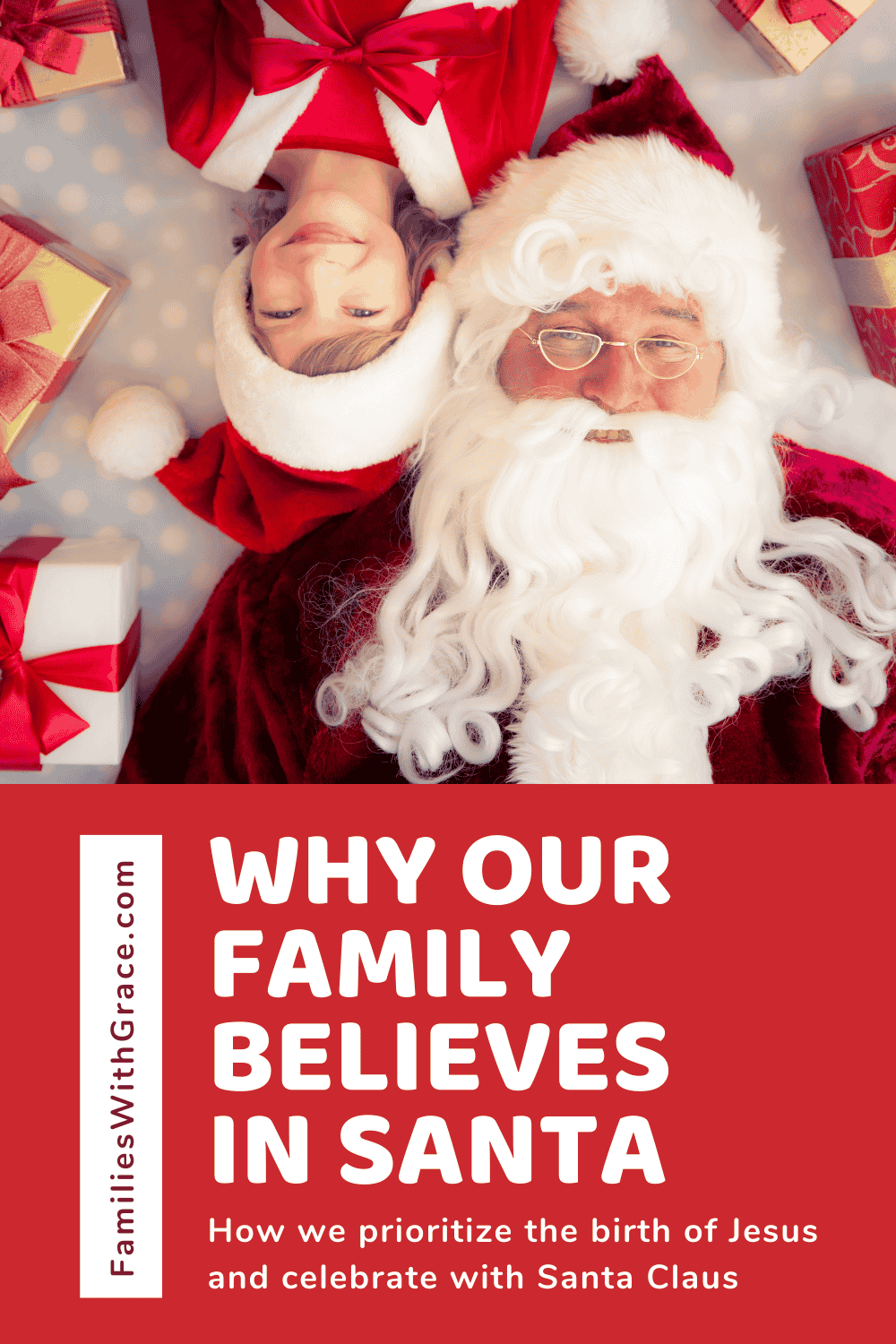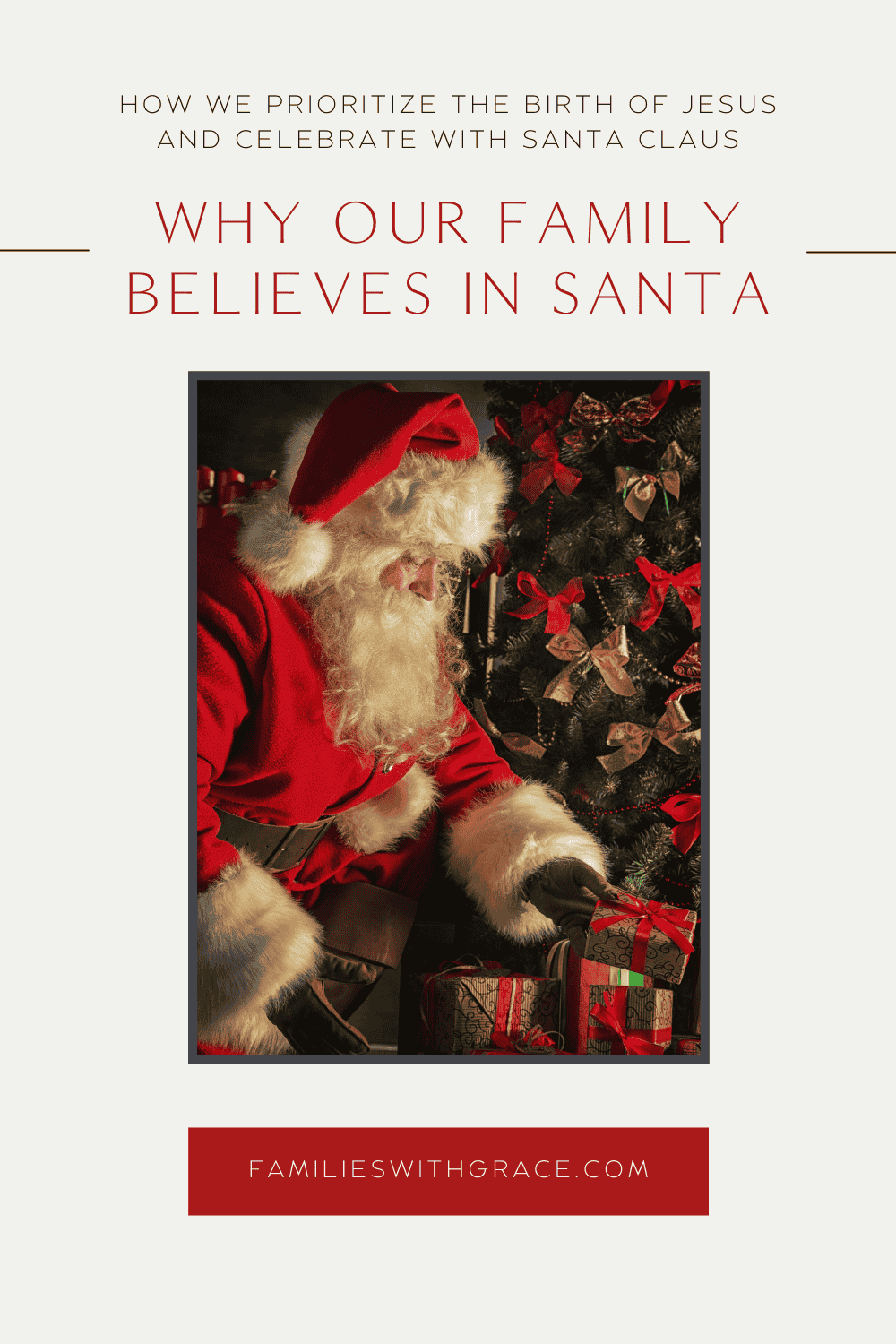How we prioritize the birth of Jesus and celebrate with Santa Claus
Affiliate links are used in this post. If you make a qualifying purchase via my link, I receive a small percentage of the sale at no additional cost to you. I only recommend products and services I use and love. It helps support my blog, so thank you for your support! Read my full disclosure here. This post is in no way sponsored by or affiliated with Elf on the Shelf or any of its products.
I originally wrote these words in December of 2013. My kids were 4 and almost 1 that Christmas. Now they are 12 and almost 9. We have had a conversation about Santa with our oldest who now enjoys sharing Santa with her little brother. Our Santa holidays are winding down, but I don’t regret them one bit. This post explains why.
Santa Claus. The jolly figure incites a variety of feelings in various folks. Some insist that they won’t let their kids believe in Santa. They contend that they won’t lie to their children or that Santa isn’t the reason for the season. Others insist that Santa is a huge part of their Christmas celebration and even as adults they believe in him to some degree.
What Santa is like at our house
Around my house, my kids believe in Santa Claus. However, they also know the full truth of the Christmas season. Well, at least the 4-year-old does, but the baby will learn about Jesus’ birthday one of these days, too. The Santa that exists around here is one who brings some gifts on Christmas morning. He is one we go to visit at the mall and smile for a photo. He is one for whom we leave out cookies and milk. Our Santa is one who leaves a letter for the kiddos and sometimes sends a video message. And that’s pretty much our extent of celebrating with Santa.
We don’t threaten that if behavior isn’t good then he won’t bring gifts. We expect good behavior year-round just because that’s what is expected. Our children must learn obedience as simply the right thing to do. We have a trust relationship in that way. We won’t lead them astray if they follow our instructions. (That’s the theory, anyway. The practice is just that — practice!)
My history with Santa

My husband and I both grew up believing in Santa. I very distinctly remember finding out that he wasn’t real. My mom was drying my hair. I asked her if Santa really existed. I think she tried to change the subject, but I was as persistent with my questions then as a child as I am now as a journalist. She told me gently that he was pretend. It didn’t traumatize me at all. I just understood that I was old enough to know and be in on the other side of the fun secret. I understood the tradition of Santa as well. In fact, I continued to leave out milk and cookies for him into my teen years and quite enjoyed doing so.
One of my family’s traditions of Santa included a letter from him. I do remember noticing that his handwriting looked a lot like my mom’s the year before I found out the truth. (Thank goodness for computers! I now type the letters for my kiddos.) My mom was creative and I looked forward to those letters, even after I knew the truth.
The real meaning of Christmas
So, I will let my children continue to believe in Santa Claus as long as they can. While we didn’t really introduce Santa to my daughter from the start in a very tangible way, she learned about him and fell in love with him. But she also learned about Jesus’ birth and fell in love with Him. That’s the most important part. In our slew of Christmas books, the vast majority focus on the birth of Jesus. My daughter can tell you all about how Jesus was born in a manger because there was no room in the inn and that a bright star lead shepherds to find Him. For example, last week we were outside after dark and she saw a bright star. She thought that was the Star of David.
Even better to me, my child fully understands why the birth of Jesus is so great. We read the story of Jesus’ birth the other day. Then she turned to me and said, “Now let’s read the other story of when Jesus grows up and goes back up into heaven.” She gets it as much as a 4-year-old can get it. Believing in Santa and the fun that comes with that belief hasn’t impeded on her understanding the true meaning of Christmas.
We also very much enjoy the VeggieTales story of St. Nicholas. St. Nicholas, in whom Santa is rooted, is a testament to giving to those in need. That gives us a chance to talk about giving gifts as a celebration of Jesus’ birth. We talk about how Santa is good. After all, what I like most about Santa is his spirit. He has a spirit of kindness and generosity. He has a touch of magic with flying reindeer, laying his finger beside his nose and disappearing. And he has a spirit of fun and laughter with his jolly “Ho, ho, hos!” Santa offers a wonderment that enhances a Christmas season with little ones.
The future
One of these days, my children will learn the truth. We’ll talk about it. I’ll answer any questions they have and I will tell them some of these very things. I will tell them that the spirit of Santa is very real in spite of his lack of corporeal form. I’ll tell them that they are now old enough to be in on the secret and help share in the wonderment of the little ones that come after them. And we’ll continue any holiday traditions they enjoy. At the end of the conversation, they will still trust me. I am their mother. A trusting relationship is of the utmost importance to me.
Even by now, my almost 11-month-old knows he can trust me to take care of his needs. If he’s crying in his crib, he stops as soon as I enter the room. He’s learned I’m on it and will take care of him. Believing in Santa and later learning the truth isn’t going to change the innate trust and relationship we’ve built.
And so this year, my kiddos will believe in Santa Claus. I make no apologies for that and am not ashamed of that. I look forward to the excitement that will come in picking cookies to leave out for him and see what he’s brought come Christmas morning.
An update from the present (2021)
In the years since I first wrote this post, some things have changed. My kids have gotten older. When she was 10, my oldest had a few experiences that led her to believe maybe Santa wasn’t real. My husband and I took her out to dinner to her favorite restaurant and we chatted one-on-one.
She wasn’t devastated. Of course she had some questions, but she was fine about it. And she was super excited to help continue the spirit of Santa with her younger brother.
My youngest will be 9 in a couple of months. I know it won’t be much longer until we’ll have a similar conversation with him. We have had some great family memories made over these past few Christmases that I am thankful for.
A few years ago, we also introduced our version of Elf on the Shelf. Much like Santa, the elf isn’t about monitoring behavior in our family. He is about having some clean fun. (Check out “14 Ways we made Elf on the Shelf work for our family” for more info. You can also find some elf pose ideas and a free Santa letter printable.)
How we’ve kept Jesus the focus of Christmas
We have also worked to make sure that from the beginning our kids knew Christmas was more about celebrating the birth of Jesus. One of the first ways we did this was by reading a Bible verse or two a day from Dec. 1 through 25 that led through the birth of Jesus. Each night, we’d review what had happened in the story so far. (Check out “8 Simple Christmas traditions to bring your family closer” for more info on how we did the verses as well as free printable verses your family can use.)
The verse tradition has grown into a devotion time each evening in December. We started with “A Family Christmas, Volume 1” and are now moving on to “A Family Christmas, Volume 2.” Both books have 5-minutes daily devotions for Dec. 1 through 25 to go through the Christmas story.





